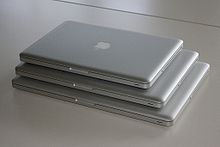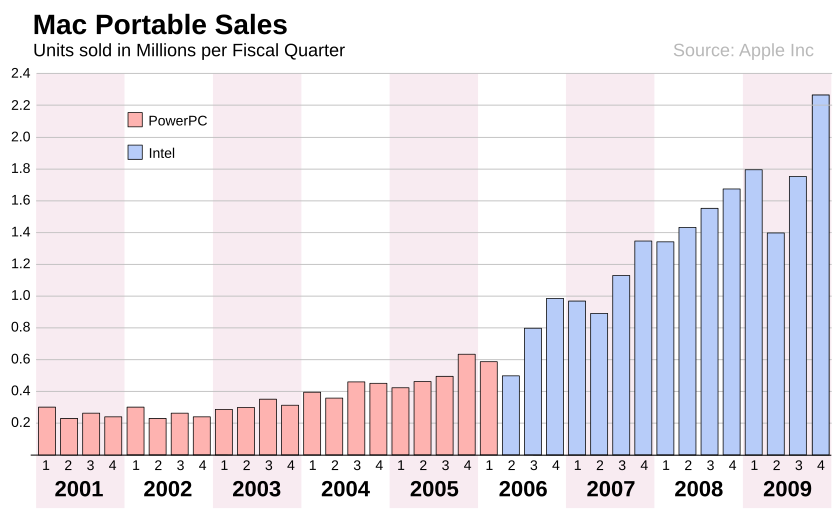MacBook
The MacBook family is a brand of Macintosh laptop computers by Apple Inc. that merged the PowerBook and iBook lines during Apple's transition to Intel processors. The current lineup consists of the MacBook (2006–present),[1] the MacBook Air (2008–present), and the MacBook Pro (2006–present). The new MacBook (2015) is the only MacBook that does not incorporate the use of a MagSafe charger, but rather a USB Type-C port.
Overview
The MacBook family were initially housed in designs similar to the iBook and PowerBook lines which preceded them, now making use of a unibody aluminum construction first introduced with the MacBook Air. This new construction also has a black plastic keyboard that was first used on the MacBook Air, which itself was inspired by the sunken keyboard of the original polycarbonate MacBooks. The now standardized keyboard brings congruity to the MacBook line, with black keys on a metallic aluminum body.
The lids of the MacBook family are held closed by a magnet with no mechanical latch, a design element first introduced with the polycarbonate MacBook. Memory, drives, and batteries were accessible in the old MacBook lineup, though the newest compact lineup solders or glues all such components in place.
The MacBook was discontinued until April 2015, when a new model featuring an ultraportable design and an all-metal enclosure was introduced. All of the current MacBooks feature backlit keyboards. The unibody MacBook refresh introduced a Mini DisplayPort. The MacBooks featured two USB 3.0 ports, while the 17-inch MacBook Pro (now discontinued) contained two.[2] The revised polycarbonate MacBook was the first Mac since the iBook DV to lack FireWire ports.
Current MacBook family models

MacBook

The MacBook features many firsts from Apple, including a butterfly mechanism keyboard, the Force Touch trackpad, and a USB Type-C port.[3] This lack of Type-A USB ports ubiquitous among modern PCs means it requires a mechanical adapter to attach almost any 3rd-party peripheral on release. The ports consist of one USB Type-C, able to charge the MacBook, and a headphone/microphone jack compatible with inline remote control. Adapters are available for USB, mDP, HDMI, and VGA.[4] This Apple laptop is also the first in 17 years since the “Wallstreet” PowerBook G3 to lack a translucent illuminated Apple logo on the back of its lid, instead having a polished metal logo.
MacBook Air
The MacBook Air is Apple's least expensive notebook computer.[5] It comes in an 11-inch configuration and a 13-inch configuration, and was Apple's thinnest notebook computer until the introduction of the MacBook in March 2015. This model of MacBook does not have a Retina Display.
MacBook Pro
The MacBook Pro features FireWire 800, a Thunderbolt port, an SD Card slot (ExpressCard/34 slot on the discontinued 17-inch model), 2 Type-A USB 3.0 ports, Ethernet, and a DVD drive.[6]
The MacBook Pro without Retina Display now comes in only one 13 inch model.[7]
MacBook Pro with Retina Display
The MacBook Pro with Retina Display features 2 Thunderbolt ports, an SD Card slot, 2 USB Type-A 3.0 ports and an HDMI port.[8] This was the first of any MacBook models to feature an HDMI port. Its headline feature is a high resolution display (227 PPI on the 13 inch model, 220 PPI for the 15 inch model).
Comparisons
Template:Comparison of Macintosh laptop models
| Timeline of portable Macintoshes |
|---|
 |
| Timeline of portable Macintoshes |
|---|
 |
Sales
See also
| Mac transition to Intel processors |
|---|
 |
References
- ^ Snell, Jason (July 20, 2011). "Apple discontinues the $999 MacBook". Macworld. Mac Publishing. Retrieved September 5, 2012.
- ^ "MacBook vs MacBook Pro". Retrieved April 23, 2011.
- ^ "MacBook". Apple.com. Apple. Retrieved March 10, 2015.
- ^ "MacBook - Design". Apple.com. Apple. Retrieved March 10, 2015.
- ^ "Macbook Air". Apple.com. Apple. Retrieved March 10, 2015.
- ^ "Macbook Pro Tech Specs". Apple.com. Apple. Retrieved March 10, 2015.
- ^ "Apple". Apple.com. Apple. Retrieved March 10, 2015.
- ^ "Apple MacBook Pro with Retina Display Tech Specs". Apple.com. Apple. Retrieved March 10, 2015.

